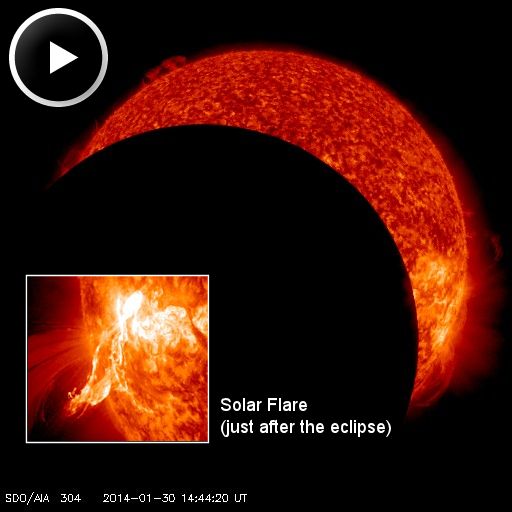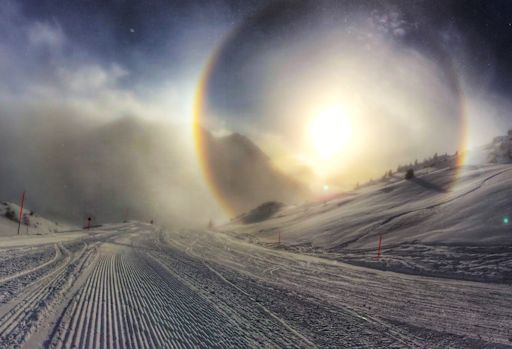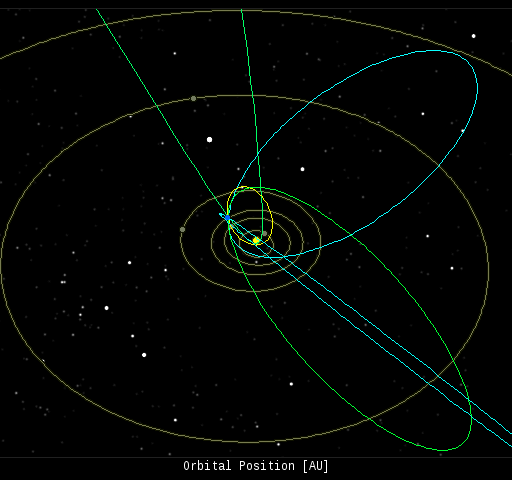When is the best time to see auroras? Where is the best place to go? And how do you photograph them? These questions and more are answered in a new book, Northern Lights - a Guide, by Pal Brekke & Fredrik Broms. | | | STRONG M-FLARE AND CME: Yesterday, Jan. 30th, big sunspot AR1967 unleashed a strong M6-class solar flare. The explosion sent a CME racing away from the blast site faster than 1400 km/s (3 million mph): movie. The cloud appears to have an Earth-directed component, and could deliver a glancing blow to our planet's magnetic field on Feb 1st. Aurora alerts: text, voice LUNAR TRANSIT OF THE SUN: On Jan. 30th, the Moon passed almost directly in front of the sun. No darkness fell on Earth, however, because the "lunar transit" was only visible from space. NASA's Solar Dynamics Observatory (SDO) recorded the entire passage from geosynchronous orbit: 
At maximum eclipse as much as 90% of the sun was covered. SDO is solar powered, but it did not "brown out" because mission controllers put an extra charge on the spacecraft's batteries ahead of time. Every year, SDO observes multiple lunar transits. This one, lasting almost 2.5 hours, was the longest in the history of the spacecraft's 4 year mission. A highlight of the movie occurs just after the eclipse is finished when sunspot AR1967 erupts. A plume of hot plasma flies away from one side of the sun just as the Moon is exiting the other. That eruption is the source of the CME that could deliver a glancing blow to Earth's magnetic field on Feb. 1st. Realtime Space Weather Photo Gallery DIAMOND DUST SKI HALO: Ski resorts are one of the best places to see sun halos--rings of light that surround the sun when ice crystals fill the air. The most sublime halos are caused by jewel-like crystals called "diamond dust." On Jan. 29th, Christian Schartner was skiing in Obertauern, Austria, when he witnessed this specimen: 
"The outside temperature was quite chilly at -12°C when we hit the slopes," says Schartner. "Beautiful sun halos made our skiing day even better!" Most sun halos are caused by ice crystals floating high above Earth's surface in cirrus clouds. "Ski halos," on the other hand, are formed by ice crystals near the ground, kicked into the air by the action of skis and snow-making machines. A close look at Schartner's picture shows specks of light in the air. Those are the glittering crystals of diamond dust which make these halos so beautiful. If you're on the slopes this weekend, and the sun dips behind a cloud of ice, be alert for "ski halos." They can make your day. Realtime Aurora Photo Gallery
Realtime Supernova Photo Gallery
Every night, a network of NASA all-sky cameras scans the skies above the United States for meteoritic fireballs. Automated software maintained by NASA's Meteoroid Environment Office calculates their orbits, velocity, penetration depth in Earth's atmosphere and many other characteristics. Daily results are presented here on Spaceweather.com. On Jan. 31, 2014, the network reported 5 fireballs.
(5 sporadics) 
In this diagram of the inner solar system, all of the fireball orbits intersect at a single point--Earth. The orbits are color-coded by velocity, from slow (red) to fast (blue). [Larger image] [movies]
Potentially Hazardous Asteroids ( PHAs) are space rocks larger than approximately 100m that can come closer to Earth than 0.05 AU. None of the known PHAs is on a collision course with our planet, although astronomers are finding new ones all the time. On January 31, 2014 there were potentially hazardous asteroids. Notes: LD means "Lunar Distance." 1 LD = 384,401 km, the distance between Earth and the Moon. 1 LD also equals 0.00256 AU. MAG is the visual magnitude of the asteroid on the date of closest approach. | | The official U.S. government space weather bureau | | | The first place to look for information about sundogs, pillars, rainbows and related phenomena. | | | Researchers call it a "Hubble for the sun." SDO is the most advanced solar observatory ever. | | | 3D views of the sun from NASA's Solar and Terrestrial Relations Observatory | | | Realtime and archival images of the Sun from SOHO. | | | from the NOAA Space Environment Center | | | the underlying science of space weather | | 
